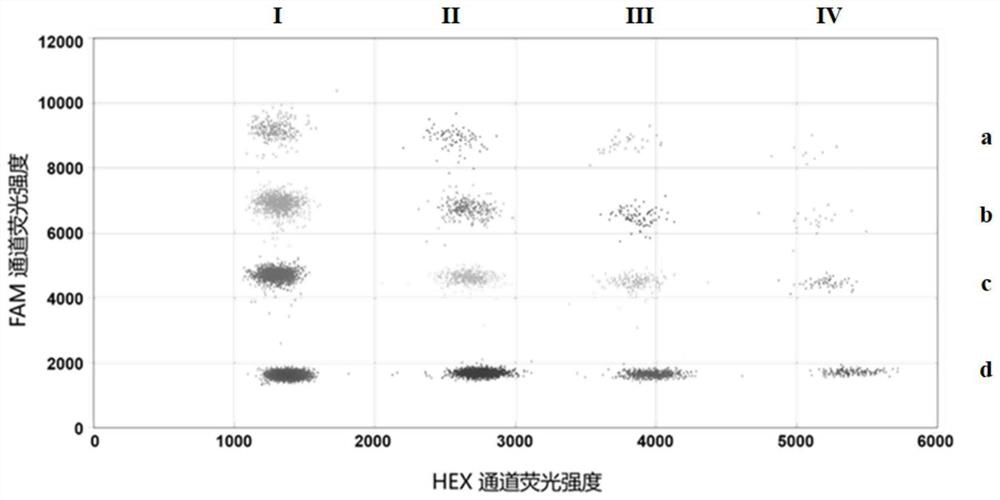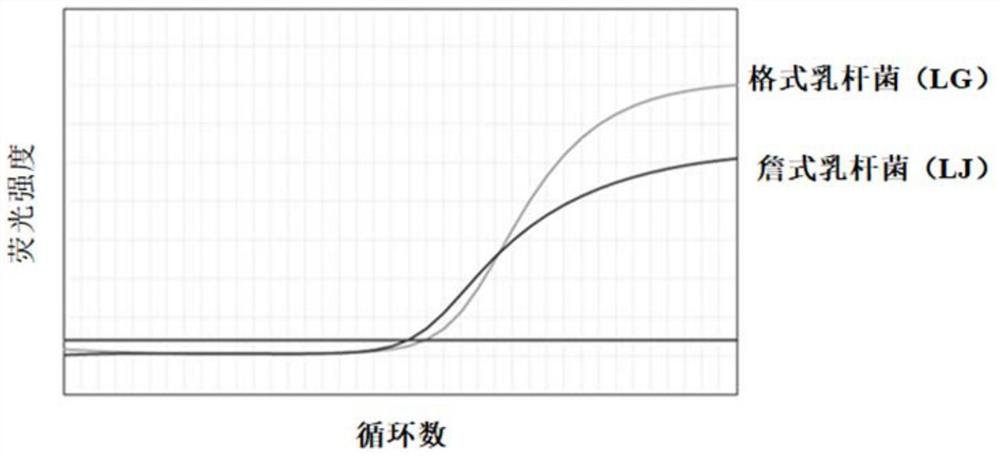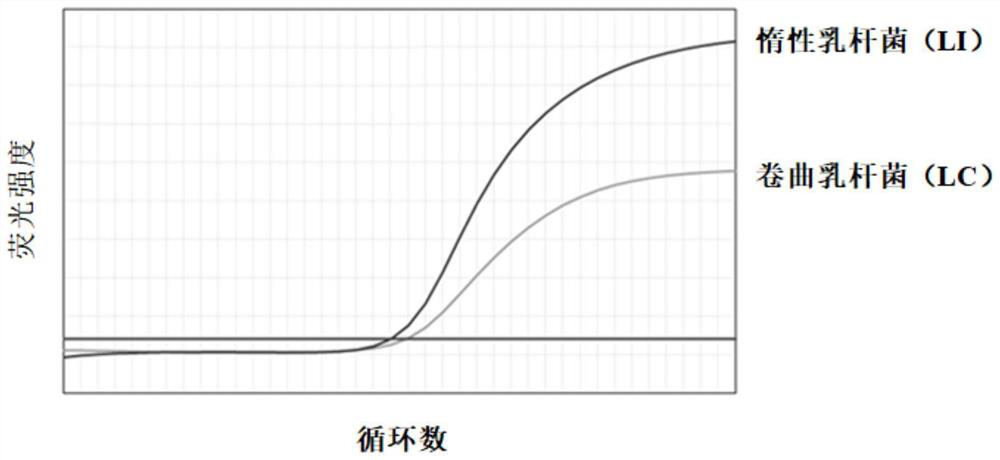Primer probe combination for detecting female vaginal microorganisms based on quadruple droplet digital PCR and application of primer probe combination
A primer probe and microorganism technology, applied in the field of microorganism detection, can solve the problems of complicated operation, complicated preparation and dyeing, etc., and achieve the effect of specific amplification
- Summary
- Abstract
- Description
- Claims
- Application Information
AI Technical Summary
Problems solved by technology
Method used
Image
Examples
Embodiment 1
[0062] This embodiment provides a primer-probe combination and a method for detecting vaginal microorganisms using it.
[0063] (1) Primer design
[0064] In order to distinguish the four species of Lactobacillus (LI, LJ, LC, LG) to be detected, the unique genes of the four species of Lactobacillus were selected in this example to design primers and probes, thereby ensuring the specificity of the primers , to avoid primers that amplify other strains.
[0065] Among them, the specific genes are the folE gene of Lactobacillus inere (LI), the gapR gene of Lactobacillus janesus (LJ), the CbiQ1 gene of Lactobacillus crispatus (LC) and the murQ gene of Lactobacillus formatiformis (LG). The sequences of the primers are as follows:
[0066] LI folE forward primer (SEQ ID NO: 1):
[0067] 5'-GTGGCAGTAGGTGAAGATCC-3';
[0068] LI folE reverse primer (SEQ ID NO:2):
[0069] 5'-TGGTCGATGATTGAGTGACG-3';
[0070] LJ gapR forward primer (SEQ ID NO:3):
[0071] 5'-GCGAATTGGAGTTTGTTCCG-3...
Embodiment 2
[0111] In the present embodiment, the primer probe combination and detection method provided in Example 1 are used to carry out the plasmid mixture of Lactobacillus inert (LI), Lactobacillus janesus (LJ), Lactobacillus crispatus (LC), and Lactobacillus formatiformis (LG). Typing.
[0112] Specific steps are as follows:
[0113] (1) Design primers for LI folE, LJ gapR, LC CbiQ1, and LG murQ genes, and use primers to amplify LI folE, LJ gapR, LC CbiQ1, and LG murQ from gDNA extracted from clinically isolated LI, LJ, LC, and LG strains, respectively The gene fragments were cloned and transformed using the pEASY-Blunt Cloning Kit;
[0114] (2) Use TaKaRa MiniBEST Plasmid Purification Kit Ver.4.0 (TaKaRa) to extract plasmids from E.coli;
[0115] (3) Mix the plasmids of LI folE, LJ gapR, LC CbiQ1, and LG murQ as the sample to be tested, and the concentration of each plasmid is 2×10 3 copies / μL; the rest of the detection steps were carried out with the steps described in the refe...
Embodiment 3
[0121] The difference from Example 2 is that in this example, ddPCR is not used for amplification, and only a general amplification method is used for amplification, that is, after mixing the primer-probe combination with the sample, the PCR reaction system is directly prepared, and Perform fluorescent quantitative PCR;
[0122] Among them, the fluorescent quantitative PCR uses a 20 μL reaction system, including a reaction system a for detecting LG and LJ and a reaction system b for detecting LC and LI.
[0123] Reaction system a is shown in Table 4 below:
[0124] Table 4
[0125]
[0126]
[0127] Wherein, after the reaction system is prepared, the concentration of each primer is 300nM; the concentration of the LJ gapR probe is 200nM, and the concentration of the LG murQ probe is 200nM.
[0128] Reaction system b is shown in Table 5 below:
[0129] table 5
[0130]
[0131] Wherein, after the reaction system is prepared, the concentration of each primer is 300nM...
PUM
 Login to View More
Login to View More Abstract
Description
Claims
Application Information
 Login to View More
Login to View More - R&D
- Intellectual Property
- Life Sciences
- Materials
- Tech Scout
- Unparalleled Data Quality
- Higher Quality Content
- 60% Fewer Hallucinations
Browse by: Latest US Patents, China's latest patents, Technical Efficacy Thesaurus, Application Domain, Technology Topic, Popular Technical Reports.
© 2025 PatSnap. All rights reserved.Legal|Privacy policy|Modern Slavery Act Transparency Statement|Sitemap|About US| Contact US: help@patsnap.com



